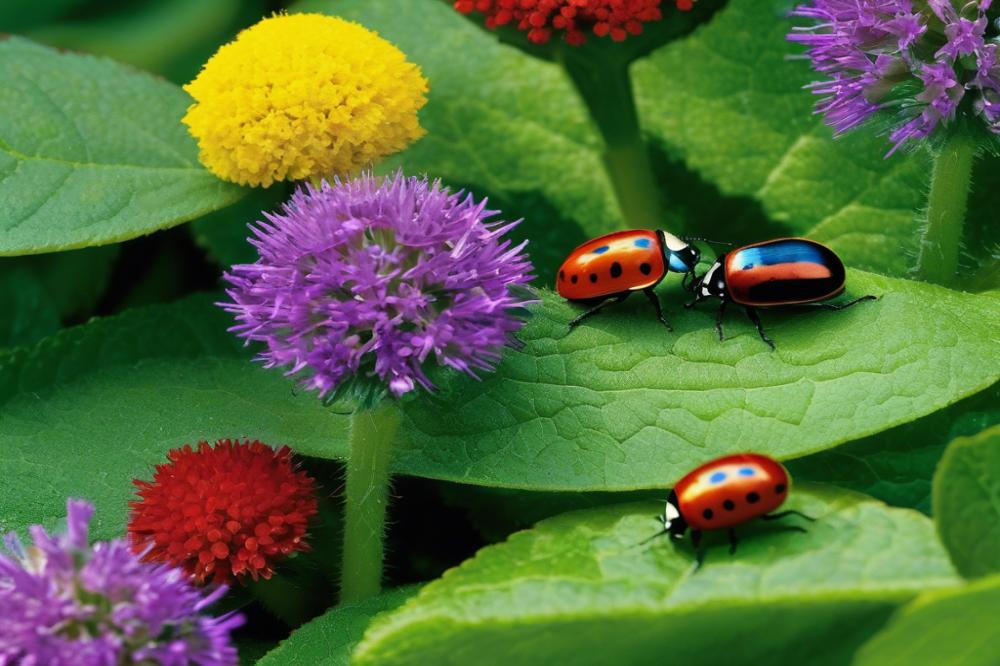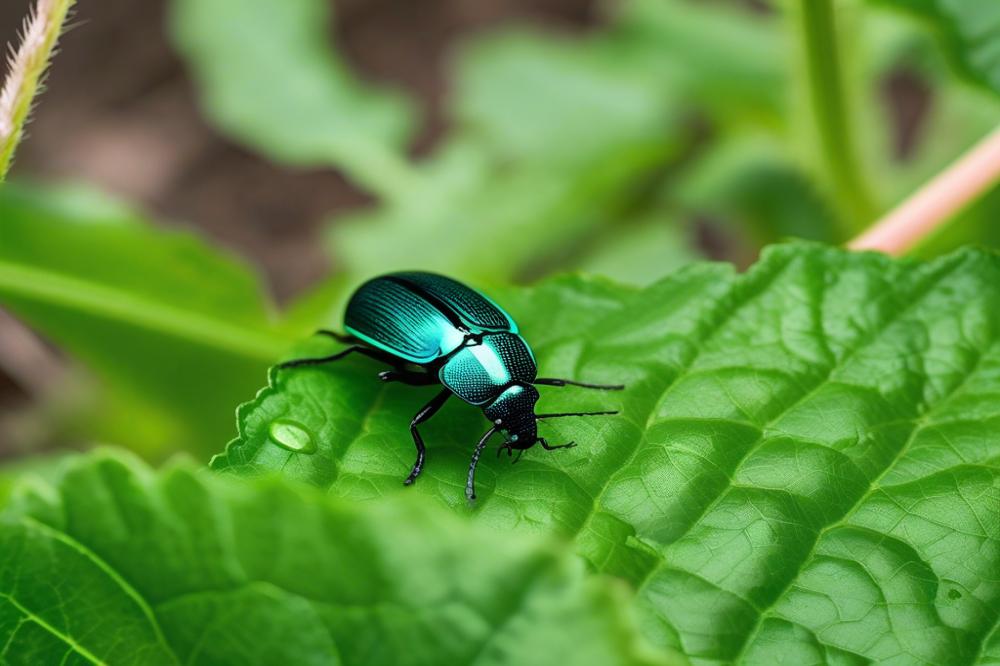Overview of Flea Beetles as Common garden pests
Gardeners often face challenges from various pests, and among these, Flea Beetles stand out. These tiny, jumping insects are notorious for their ability to cause significant Plant Damage. Their glossy bodies and nimble movements make them difficult to spot until the harm is already done. Vegetables such as eggplant, lettuce, and radishes are particularly vulnerable. With a strong appetite for foliage, these pests can quickly decimate young seedlings and established plants alike.
Addressing the threat posed by flea beetles is crucial for maintaining soil health and promoting thriving gardens. Left unchecked, a small infestation can escalate, leading to crop failure and financial loss for growers. Combatting these pests doesn’t always require harsh insecticides; many gardeners look to organic solutions that prioritize garden protection while minimizing harm to beneficial insects. Implementing effective pest management techniques can make a significant difference.
Gardeners must employ a variety of prevention methods to protect their plants. Regular monitoring can help detect infestations early. Utilizing row covers or companion planting can also deter these pests from damaging crops. Sharing gardening tips within local communities can foster a collective effort against these pests. With the right strategies in place, gardeners can enjoy successful crops and vibrant gardens throughout the growing season.
Understanding Flea Beetles


Flea beetles are small insects notorious for damaging various plants. These pests usually measure about 1/16 to 1/8 of an inch long. Their bodies are shiny and can be black, metallic blue, or bronze in color. Identifying them is often easy due to their characteristic hopping behavior. When disturbed, they leap away similar to how a flea would move. This unique movement is why they are named flea beetles.
Common Species of Flea Beetles Affecting Gardens
Several species of flea beetles are common in gardens. The most notable ones include the striped flea beetle and the black flea beetle. The striped type has distinctive stripes running along its back. This design makes it stand out among other insects. The black variety, on the other hand, is solidly colored. Each type targets different vegetables like eggplants, tomatoes, and potatoes.
Life Cycle and Behavior of Flea Beetles
The life cycle of these pests involves four stages: egg, larva, pupa, and adult. After mating, females lay tiny eggs in the soil near host plants. Soon, the larvae hatch and begin feeding on the roots. Damage can lead to crop failure if left unchecked. Adult beetles generally emerge in spring as temperatures rise. They often come out when vegetables are young and vulnerable, making them especially dangerous.
Behaviorally, flea beetles are most active during warm weather. They are attracted to light and tend to congregate on leaves. This can cause significant harm to plants if not managed properly. Effective pest control measures include regular inspections and monitoring. garden protection strategies, such as row covers, can deter them. Organic solutions are also available, allowing gardeners to avoid harmful chemicals.
Sometimes, insecticides may be necessary for severe infestations. Those who want to maintain soil health should explore prevention methods. Integrated pest management combines various tactics for effective results. Following gardening tips about crop rotation can minimize damage. Healthy plants are less susceptible, which is key for overall pest management.
Damage Caused by Flea Beetles


Flea beetles pose a severe threat to various vegetables, particularly during the early stages of growth. These tiny pests create distinct holes in leaves, leading to significant damage that hinders plant development. Young seedlings are especially vulnerable. Attack may result in stunted growth and subsequent weakness against other pests or diseases.
Plants like cabbage, eggplant, and tomatoes tend to attract these harmful insects more than others. The impact on the overall garden ecosystem can be detrimental. Unchecked populations can disrupt the balance of beneficial insects and lead to poor soil health. Additionally, a damaged plant struggles to absorb nutrients effectively.
Economic loss is often the main concern for farmers. Complete crop failure can occur if an infestation is not managed promptly. This situation could affect food supply and local economies. Therefore, pest management strategies become crucial.
Impact on Soil Health and Overall Garden Ecosystem
Healthy soil is the foundation of a thriving garden. Damage from flea beetles can result in weakened plants, which ultimately reduces soil quality. Less foliage means less organic matter is returned to the earth. This cycle allows for nutrient depletion, making gardening tips vital for recovery.
Loss of plant diversity can further impact the ecosystem. Many gardeners notice fewer pollinators or natural pest controllers in infested areas. Organic solutions focusing on building up soil health can be a rescue method. Adding compost or planting cover crops may help restore balance.
Potential for Crop Failure and Economic Loss
The risk of crop failure should concern every gardener. Infected plants may produce fewer yields, leading to financial stress for farmers. Repeated infestations can threaten long-term agricultural viability. Implementing prevention methods early is critical.
Various pest control tactics can minimize the likelihood of an outbreak. Using insecticides cautiously can help reduce damage without harming beneficial species. Garden protection methods include row covers or barrier fabrics to deter these pests.
Effective Pest Control Strategies


Overview of Pest Management Approaches
Many gardeners face the challenge of pest control. Flea beetles pose a serious threat to plant health and can lead to significant crop failure. Effective management involves multiple strategies to keep gardens healthy. A combination of prevention methods and methods of control can help maintain soil health. Healthy plants are less likely to fall victim to these pests.
Use of Insecticides: Pros and Cons
Insecticides can be a quick fix for pest issues. They may provide instant relief from an infestation. However, their use comes with risks. Chemical treatments can harm beneficial insects along with the target pests. Dependency on these chemicals might lead to resistant strains developing over time. Understanding these pros and cons helps gardeners make informed decisions.
Organic Solutions for Combating Flea Beetles
For those who prefer natural remedies, organic solutions exist. Compounds such as neem oil can deter these pests effectively. Additionally, introducing predatory insects can also help control their numbers. Crop rotation is another excellent tactic to hinder their life cycle. This approach reduces the chances of beetles returning season after season.
Importance of Gardening Tips in Prevention and Control
Gardening tips play a crucial role in keeping gardens safe. Regular monitoring of plants helps catch problems early. Mulching not only conserves moisture but also can block pests from reaching vulnerable vegetables. Choosing resistant plant varieties can also provide a robust defense. Implementing these practices greatly contributes to successful pest management.
Prevention Methods and Garden Protection


Best Practices for Protecting Gardens Against Flea Beetles
Gardening tips are essential for keeping your plants safe. First, planting in late spring can help. This timing allows young plants to grow strong enough to resist pests. Using row covers is another effective strategy. These lightweight fabrics protect vegetables without obstructing sunlight. Regularly inspecting your plants can catch problems early. If you notice any signs of damage, act quickly. Consider natural pest control methods that are safe for the environment. You don’t need to rely solely on chemical insecticides for garden protection.
Soil Health and Its Role in Preventing Infestations
Healthy soil is the cornerstone of a productive garden. Testing your soil can reveal nutrient deficiencies. Good soil supports strong plants, making them less vulnerable to pests. Adding organic matter, like compost, enriches the soil. This not only benefits plant growth but also improves root systems. Better roots lead to stronger vegetables and fewer issues with crop failure. Maintaining moisture in the soil also contributes to plant vitality. Healthy plants are more equipped to fend off unwanted intruders.
Crop Rotation and Companion Planting Strategies
Crop rotation is one of the best prevention methods available. Changing the location of plants each season disrupts pest life cycles. This technique makes it harder for pests to establish themselves. Companion planting also offers unique benefits. Some plants naturally repel insects, so combining them can deter pests effectively. For example, planting marigolds with your vegetables can act as a natural barrier. Incorporating these strategies can enhance overall pest management. Doing so creates a thriving ecosystem in your garden and reduces the chances of infestation.
Implementing an Integrated Pest Management Approach
Combining different strategies can lead to successful pest control and garden protection. A holistic approach is critical, especially when dealing with pests that threaten vegetables and crop health. Start by monitoring for signs of infestation. Regularly inspect plants for the rapid movement of small beetles, which can indicate their presence. Use a magnifying glass if needed, as these creatures can be quite small and elusive.
Identifying flea beetles quickly allows for timely action. Look for tiny holes in leaves that appear like shot holes. These markings signal that the pests are feeding on the plants. Implementing proper identification helps determine the right response. Pest management is most effective when you know which species you are dealing with, as methods can vary.
In combination with monitoring, consider evaluating the effectiveness of any measures you put in place. Organic solutions are often favored, but they must be effective. If you are using insecticides, regular checks should confirm whether they are working or if adjustments are necessary. Note that some solutions may work best for a limited time, making follow-ups essential.
Equally important is the use of prevention methods to keep gardens healthy. Rotate crops each season to disrupt the pest life cycle. This not only minimizes risks of crop failure but also optimizes soil health. Healthy soil supports stronger plants that can withstand pest damage.
Gardening tips such as introducing beneficial insects can aid your efforts greatly. Ladybugs and parasitic wasps naturally control many pests. They serve as allies in maintaining a balanced ecosystem within the garden. By recognizing the role of these helpful insects, you enhance your protective measures without resorting solely to chemicals.
Finally, remain actively engaged with your garden. Regular assessments and adjustments to your pest management strategy will lead to better outcomes. Whether you choose organic options or chemical interventions, awareness and adaptability remain key. The effort you invest translates into healthier plants and a more abundant harvest.
Final Thoughts
Addressing flea beetle infestations is crucial for maintaining healthy plants and productive gardens. Ignoring their presence can lead to significant damage. These pests chew through leaves, impacting plant growth and vitality. This damage can deter not only the plants but also the joy of gardening itself.
Employing integrated pest management strategies is an effective way to combat these invaders. This approach blends various methods, such as physical barriers, natural predators, and careful monitoring. Each tool plays a role in effective pest control. Gardeners should not rely solely on chemical treatments, as these can harm beneficial insects and disrupt the ecosystem of your garden.
Taking proactive steps will offer you the utmost in garden protection. By implementing these strategies, you create a healthier environment for your plants. As you fight against flea beetles and other pests, remember that your efforts make a difference. Together, we can cultivate thriving gardens that are resilient against these nuisances. Ultimately, the health of your garden depends on your vigilance and action.



